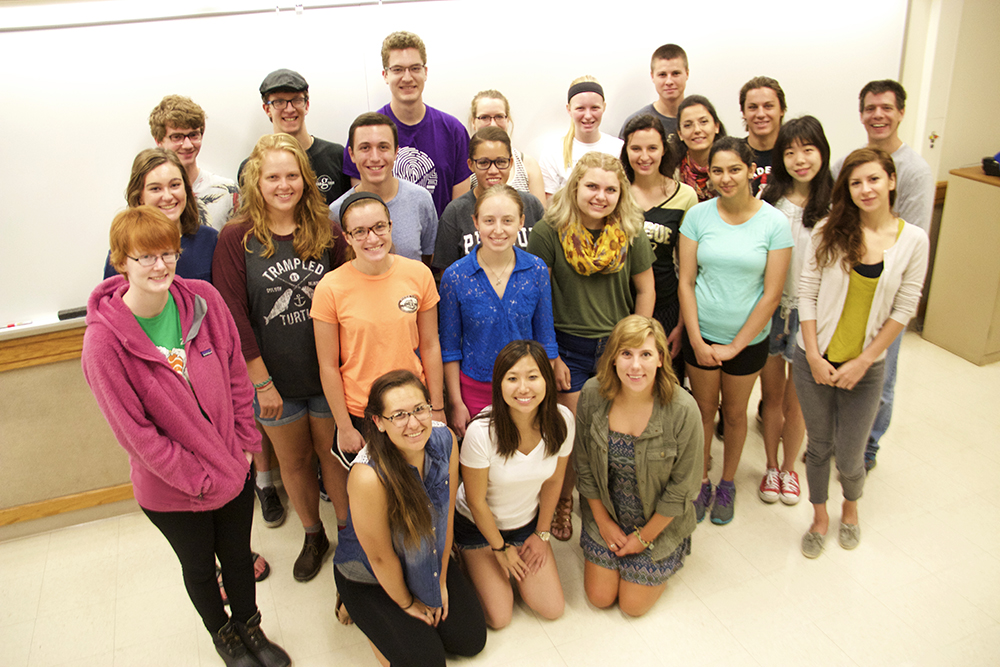Active Learning Focus of CBMS Joint Statement
Donna LaLonde, ASA, and Mark Daniel Ward, Purdue University
Most of us learn by doing. An undergraduate describing his experience at the ASA DataFest said, “On Saturday afternoon, after 24 hours of working, we found all the models we tried failed miserably. But we didn’t give up and brainstormed and discussed our problems with the VIP consultants.” Wouldn’t it be wonderful if all undergraduates expressed similar sentiments about their mathematics and statistics classes?
A joint statement, Active Learning in Postsecondary Mathematics, released in July of 2016 by the Conference Board of the Mathematical Sciences (CBMS), calls on the mathematics and statistics communities to make a commitment to create classroom learning environments that encourage students to “try, fail, and not give up.” Donna LaLonde of the ASA and Mark Daniel Ward of Purdue University represented the ASA on the writing team led by Benjamin Braun, associate professor in the department of mathematics at the University of Kentucky.
The statement was signed by all the presidents of the CBMS member organizations and offers this recommendation:
In recognition of this, we call on institutions of higher education, mathematics departments and the mathematics faculty, public policy makers, and funding agencies to invest time and resources to ensure that effective active learning is incorporated into post-secondary mathematics classrooms.
At Purdue, Ward uses active learning in his courses on probability and data analysis, and he does not foresee ever returning to lectures in these courses. In the probability course, the 40 students work in 10 teams of four students each. Students are randomly assigned to their groups every day. At the beginning of each class, Ward provides a set of questions for the students to work on during the assigned class time. He walks around the room talking to the students individually about the assignments. The class has no homework. Of course, it is advisable for the students to spend time learning in between classes. They have more than 200 videos available, and they have many hundreds of questions from previous semesters available, with solutions included.
Since the students choose how they learn the material, and since the focus of the course is on their problem-solving ability, they take ownership of the learning process. This bolsters their sense of comfort and accomplishment in the course, and they seem to enjoy the course more as a result. Since the entire semester is spent covering problems, their level of learning is deeper and more extensive, as compared to a lecture-based course.
In the data analysis course, the 21 students work in seven teams of three students each. The students work in different groups for each project, but the assignment of students to groups is not completely random. It uses a Kirkman triple system, so that each student is paired with two new people in each project, and therefore each student gets to work with each of the other 20 students exactly one time during the semester. Such an assignment of students is perhaps comparable to the real world, in which students cannot just work with their closest friends on every assignment. The students also cannot routinely fall into the role of always being the one who is in charge of the work with her/his peers, nor can any student always be a follower.
The entire course is project based, with the students working on each project for roughly 1.5 weeks at a time. Some of the projects are crafted to introduce students to new concepts, and other projects are designed to enable students to explore their own interests in data sets. All the projects tend to use large data sets, so the students cannot simply work in a spreadsheet or another traditional tool.
As in the probability course, Ward spends the class time walking around the room, discussing issues with individuals and teams as they work on their projects. They usually put music (selected by the students) on the overhead class speakers during class, so the atmosphere is relaxed and conducive to learning in the way they might work if they were creating their own learning environment.
In their guest editorial to the recent special issue of The American Statistician dedicated to statistics and the undergraduate curriculum (volume 69, issue 4), Jo Hardin and Nick Horton posed the question, “How do we ensure that students have flexible problem-solving skills to tackle future problems using data with techniques and technology that may not yet exist?” Ward and LaLonde think creating active learning environments is part of the answer.











 (2 votes, average: 4.50 out of 5)
(2 votes, average: 4.50 out of 5)







There are several critical components and benefits. Among these are working on real problem, doing research, finding a solution in a timely manner, finding reasonable approximations, working with different groups of people, and communicating results to different groups of students and non-students. I applaud this work and would like to see similar activities at the secondary school level.